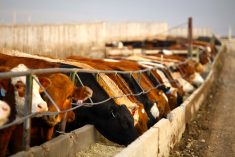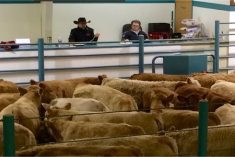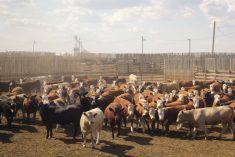Western Canadian feeder cattle prices were relatively steady early in the week but dropped $3 to $6 on average by Friday. Weakness at local auction barns was led by a softer fed cattle market and a extreme weakness in U.S. feeder values.
U.S. fed cattle prices in Kansas have dropped like a power window, trading at $156 to $157, compared to $173 earlier in December. Alberta packers were on the sidelines due to this price uncertainty but ideas are we will see similar weakness in the Alberta fed market early in the New Year. U.S. wholesale choice beef was quoted at $242 on Friday, down from late November values of $257. Alberta feedlot margins now have potential to drop into red ink by $80 to $100 per head later in January, which has feedlot operators very nervous for unhedged cattle. Buyers were pricing replacement cattle based on fed cattle at $160, compared to the recent highs of $176.
Read Also

Alberta crop conditions improve: report
Varied precipitation and warm temperatures were generally beneficial for crop development across Alberta during the week ended July 8, according to the latest provincial crop report released July 11.
On Monday, central Alberta cattle prices traded even with week-ago levels as a mixed group steers averaging 570 pounds with no special features sold for $282. By Friday, a group of 50 exotic steers just under 600 lbs. were quoted at $274 in the same region. Smaller groups or stragglers were being discounted by nearly $15 to $20 from average prices. Buyers totally backed away from cattle with any sign of stress or health issue. Lighter weight calves under 500 lbs. were holding value but this may be short-term. U.S. feeder cattle prices were under pressure trading $10 to $15 lower on average.
U.S. corn and Canadian barley prices have been slowly percolating higher. Cattle producers should be aware that U.S. corn acres have potential to drop by three to five per cent in 2015, which could add $30 to $40 per tonne onto barley prices by July. Keep in mind Canadian barley fundamentals are extremely tight. Overhanging the weakness in fed cattle prices is the potential for higher input costs over the next six months.
The U.S. Department of Agriculture’s Cattle-on-Feed report showed total inventories as of Dec. 1 up one per cent from Dec. 1, 2013. Fed and feeder markets have been encouraging expansion while rationing beef demand. Secondly, after a robust economic fourth quarter, the beef complex is factoring in a contraction in consumer spending in January, resulting in lower wholesale beef values. This recent move in the U.S. market is a serious rejection from the recent highs and I would say the upside is now defined.
— Jerry Klassen is a commodity market analyst in Winnipeg and maintains an interest in the family feedlot in southern Alberta. He writes an in-depth biweekly commentary, Canadian Feedlot and Cattle Market Analysis, for feedlot operators in Canada. He can be reached by email at [email protected] for questions or comments.




















